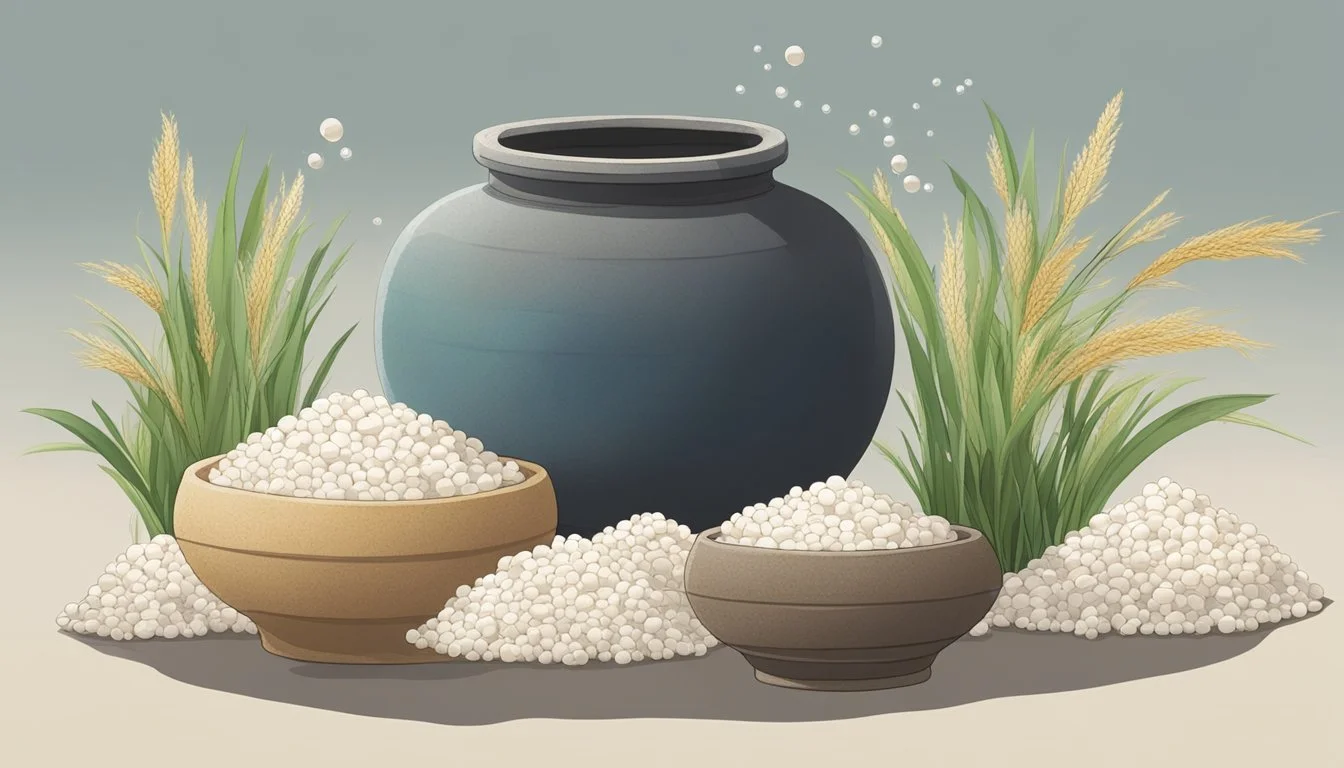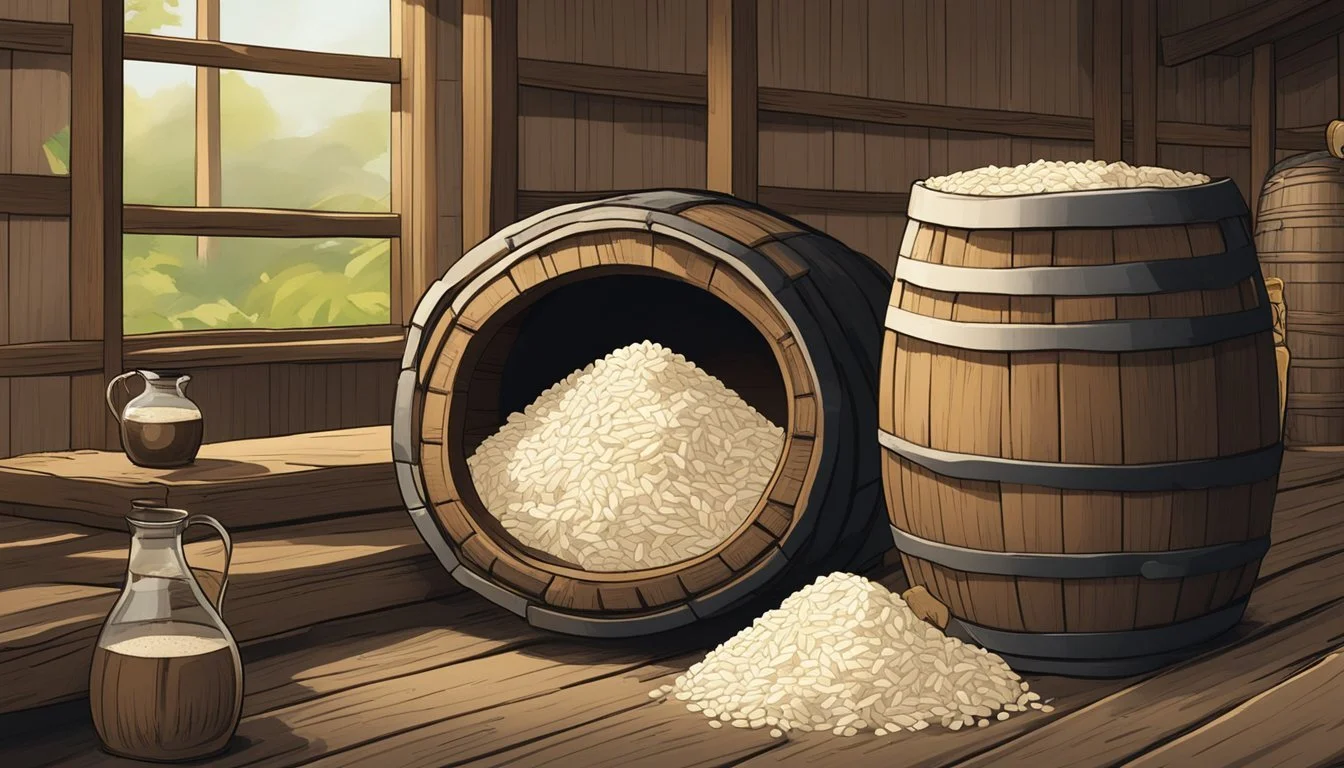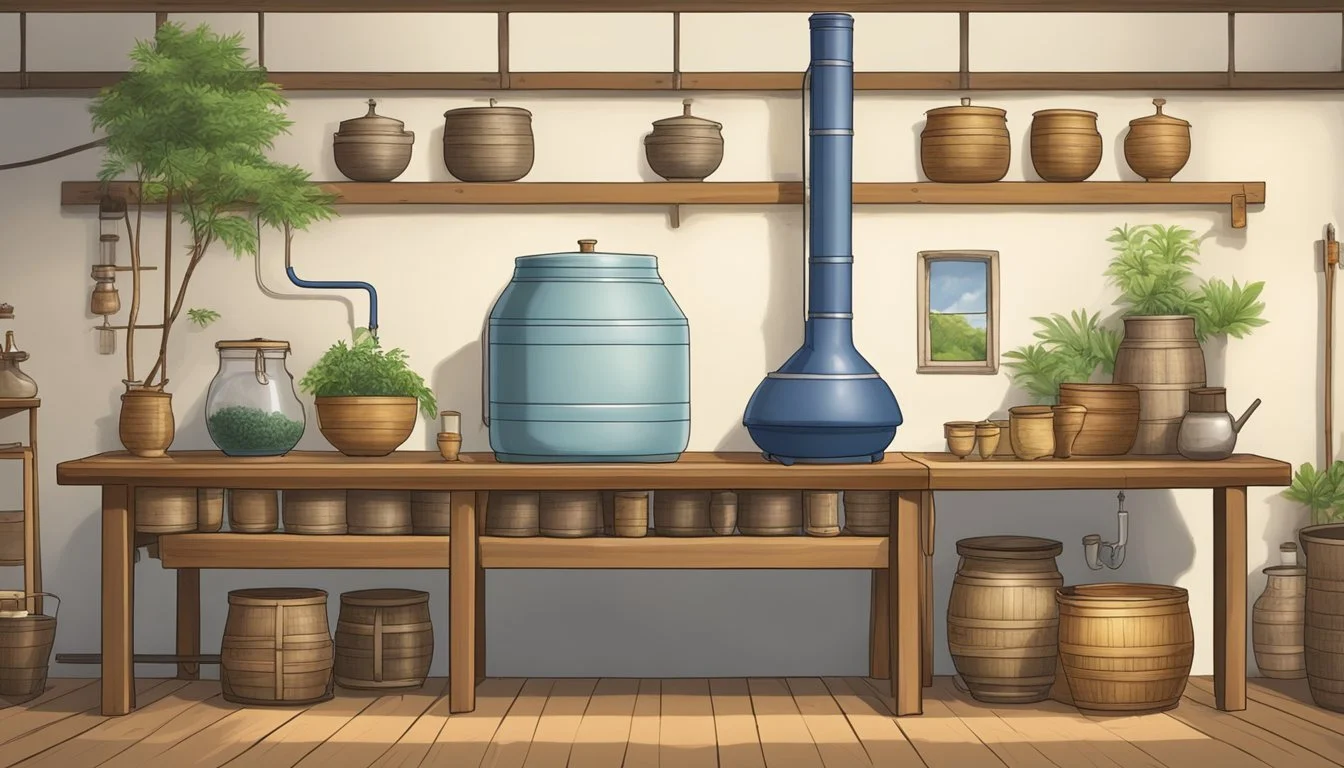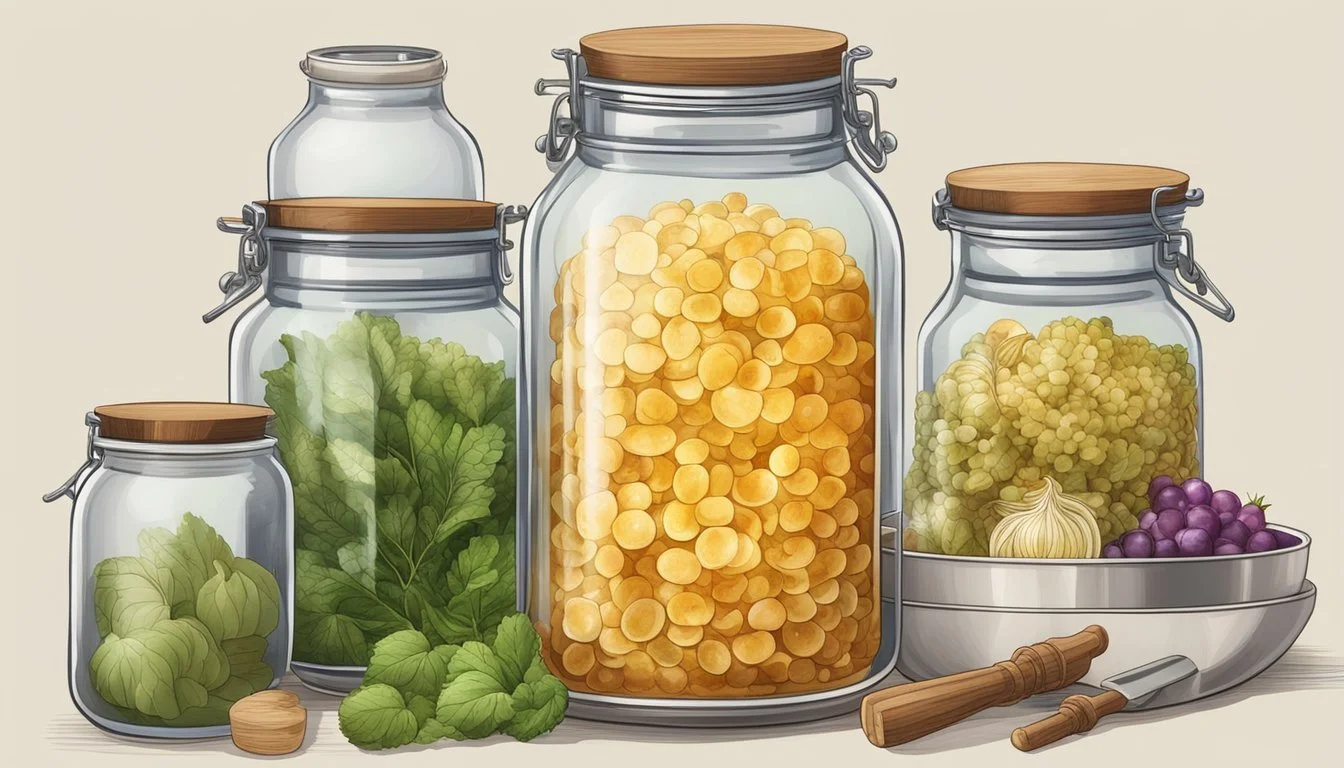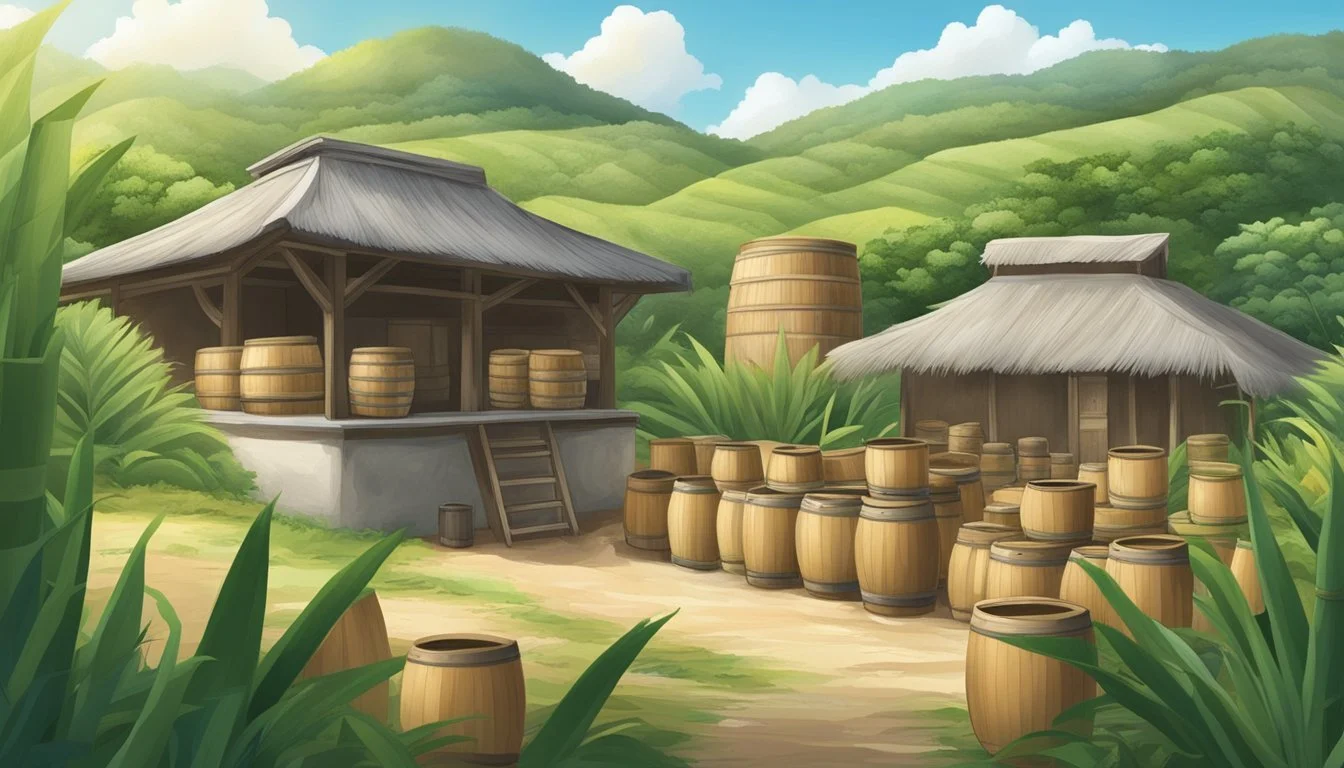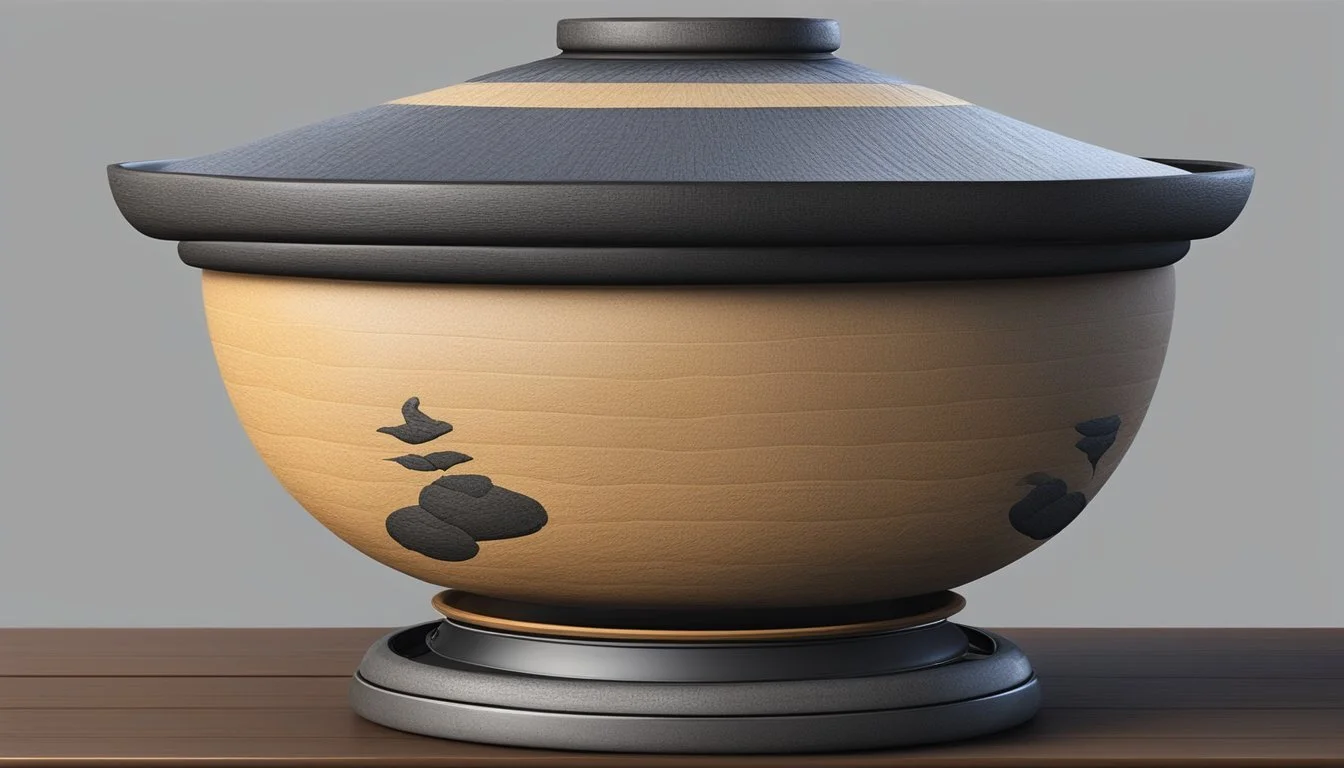How to Ferment Awamori
Mastering the Art of Okinawan Distillation
Awamori is a traditional distilled spirit hailing from Okinawa, acknowledged as one of the oldest alcoholic beverages in Japan with a history spanning over 600 years. Rooted in the customs of the Ryukyu Kingdom, it boasts a distinctive production method that sets it apart from other Japanese liquors. Unlike sake, which is brewed, or shochu, to which it is a precursor, awamori is made exclusively through distillation, which yields a clear, potent spirit with a unique flavor profile.
The process of fermenting awamori begins with long-grain indica rice, commonly imported from Thailand, which is washed, soaked, and then steamed to prepare it for fermentation. The heart of awamori's fermentation is the black koji mold (Aspergillus luchuensis), indigenous to Okinawa, which is introduced to the steamed rice. This particular mold not only initiates the fermentation process by breaking down the starches into sugars but also imparts a distinct depth and umami to the final product. The rice is then mixed with water and yeast, allowing the mixture to ferment and convert the sugars into alcohol.
In Okinawa, the appreciation of awamori is closely tied to its cultural heritage, capturing the island's spirit and history in every sip. The method of aging awamori in clay pots, or kame, further develops its flavor, often giving rise to smooth, mellow notes that can be enjoyed over many years. As a symbol of Okinawan identity and craftsmanship, awamori continues to be a source of pride and a significant aspect of the islands' social and ceremonial life.
History of Awamori
Awamori has its roots in the rich history of the Ryukyu Kingdom, drawing significant influence from its trade connections with Thailand.
Ryukyu Kingdom and Awamori
The origins of Awamori are deeply entwined with the Ryukyu Kingdom, a sovereign monarchy that existed on the Okinawa islands from the 15th to the 19th century. The distillation techniques necessary for creating Awamori, which differ notably from other Japanese spirits, were developed during this time. Historical records suggest that the Ryukyu Kingdom's thriving trade networks were partly responsible for the evolution and refinement of Awamori.
Influence of Thai Rice and the Siam Connection
The primary ingredient in Awamori is long-grain Indica rice from Thailand, formerly known as Siam. This type of rice is essential to Awamori's unique character. The connection to Siam is reflected not just in the use of Thai rice, but also in the distillation methods that were likely influenced by Siamese trading partners. Rather than sticking to local short grain varieties, the people of Okinawa opted for the distinct Thai rice to craft their iconic spirit, influencing its flavor profile and distinguishing it from other regional alcohols.
Understanding Awamori
Awamori is a traditional Okinawan distilled spirit with a unique production process and historical significance distinct from sake and shochu. Its distinct characteristics and the choice of rice varieties significantly influence its flavor profile.
Awamori vs. Sake and Shochu
Awamori originates from Okinawa and is a distilled spirit, unlike sake, which is a brewed rice wine. Sake typically uses japonica rice and undergoes a brewing process similar to beer. Shochu, like awamori, is a distilled spirit, but it can be made from different ingredients, not just rice. Shochu typically uses a single distillation process, similar to awamori, but the latter is exclusively made from long-grain Indica rice and carries unique traditions from the Ryūkyū Islands.
Characteristics of Awamori
Awamori is characterized by its use of black koji mold (Aspergillus luchuensis), essential for converting the rice starches to sugars before fermentation. This spirit is distilled only once, which preserves its robust flavor. Awamori contains a lower maximum alcohol content of 45%, and aging in clay pots enhances its taste profile over time. The aging process, which occurs in cool underground storerooms, contributes to the development of a complex depth of flavors.
Rice Varieties and Their Impact
The primary rice used in awamori production is Indica rice, specifically the Thai-Indica strain, as opposed to the japonica rice variety commonly used in sake making. Indica rice offers a unique starch composition and, when combined with black koji mold, yields a higher citric acid content during fermentation. This high citric acid level not only provides a distinctive tangy flavor but also acts as a natural preservative for the distilled spirit. The choice of rice is crucial as it directly affects the taste, texture, and quality of the awamori.
Raw Materials and Ingredients
To produce Awamori, the quality and type of raw materials play a crucial role. Specific strains of rice, black koji mold, and water are combined in a carefully controlled fermentation process to create this distinctive Okinawan spirit.
Role of Black Koji Mold
Black koji mold (Aspergillus luchuensis), or kuro kōji, is essential in Awamori production. This mold is responsible for breaking down the starches in rice into sugars, which are then fermented. The use of black koji not only initiates the fermentation but also imparts unique flavors and aromas characteristic of Awamori. Unlike other molds that may produce similar spirits, black koji mold is known for its ability to withstand the higher temperatures prevalent in Okinawa, ensuring a consistent and robust fermentation process.
Water Quality and Its Significance
The water used in Awamori production must be pure, rich in minerals, and free from contaminants. It influences the overall quality and taste of the final product. The mineral composition of the water used affects the activity of the black koji mold and the yeast during fermentation. High-quality water ensures a smoother fermentation, resulting in a cleaner and more refined taste. In Okinawa, the local water, soft in nature, is prized for its compatibility with Awamori-making.
Fermentation Process
The fermentation process of Awamori is a critical stage that involves culturing specific yeast and mold, creating a mash from rice, and carefully controlling the temperature and environment to ensure a successful fermentation resulting in the distinctive flavor of the beverage.
Culturing Yeast and Mold
In Okinawa, artisans prepare Awamori by first developing a culture of black koji mold (Aspergillus awamori) and yeast. The black koji mold is essential as it converts the starches in rice into sugars. This is followed by the addition of a yeast strain that not only survives but thrives in the unique environment, contributing to the liquor's specific taste and aroma. These microorganisms are crucial for the subsequent steps where the actual fermentation takes place, leading to the production of citric acid and alcohol.
Creating the Mash
Once the yeast and mold cultures are prepared, the next step is to produce the mash, known as moromi in Japanese. High-quality indica rice is steamed to perfection and cooled, then the prepared mold's spores are evenly sprinkled onto it, initiating the saccharification process. This mixture is later combined with the yeast culture. The yeast consumes the sugars, resulting in the gradual accumulation of alcohol within the mash.
Importance of Temperature and Environment
The fermentation process's success is also dependent on maintaining a proper temperature and environment. The optimal conditions for Awamori fermentation are a warm climate, akin to Okinawa's native environment. This is because both black koji mold and yeast require specific temperatures to activate and perform effectively. Any deviation can impede the mold's ability to produce citric acid, which is pivotal as it prevents contamination and aids in the preservation of the final product, granting Awamori its longevity and robust flavor profile.
Distillation
In the production of Awamori, the distillation process is essential for converting fermented rice mash into a clear, potent spirit. This phase is characterized by traditional methods and the reliance on single distillation to preserve flavor.
Pot Still Methodology
Awamori is distilled using pot stills, the traditional apparatus vital for its production. The pot still method involves heating the fermented mash, which contains rice, water, and black koji mold, in a large, bulbous container. The heated vessel allows the alcohol to vaporize at a lower temperature than water. These vapors are then condensed back into liquid form, resulting in distilled liquor. The pot stills are revered for their ability to impart a fuller, richer taste to the Awamori.
Single Distillation and Its Merits
Awamori is distilled once, which is a practice that differentiates it from other spirits that may undergo multiple rounds of distillation. The single distillation process has several merits:
Maintains robust flavors from the fermented mash that might be lost with multiple distillations.
Ensures a higher concentration of congeners, compounds that contribute to the taste and aroma of distilled beverages.
Produces an alcohol content that is typically less than 45%, striking a balance between potency and palatability.
Single distillation in pot stills shapes Awamori’s distinct identity, with a flavor profile that is true to its Okinawan roots.
Awamori Maturation
The maturation of Awamori profoundly impacts its flavor and quality. This process involves aging the distilled spirit under specific conditions to achieve the desired characteristics.
Aging Process and Kusu
Awamori is traditionally aged in clay pots or earthenware pots, allowing for a natural aging process that contributes to its depth of flavor. When Awamori is aged for three years or more, it is granted the title kusu, indicating its matured status. The spirit's interaction with the clay during the aging process imparts a subtle earthiness and complexity that is highly valued.
Influence of Storage Conditions
Storage conditions play a critical role in the maturation of Awamori. The beverage is typically stored in cool underground storerooms or cellars to maintain constant temperature and humidity, which are crucial for consistent aging. Exposure to varying temperatures can influence the enzymatic activities within the spirit, altering its profile.
Various Aging Periods and Their Effects
Awamori can be aged for different lengths of time, with each period imparting distinct properties:
1-3 years: Yields a smoother taste than unaged Awamori.
3-7 years: The Awamori develops more complex flavors and earns the name kusu.
Over 7 years: Results in a highly nuanced and rich taste profile.
The aging period impacts Awamori's value and desirability, with longer-aged variants being rarer and often more sought after. Whether in clay pots or transitioning to oak barrels for a different flavor profile, the selected aging vessel is as significant as the time spent maturing.
Exploring Awamori Flavors
Awamori boasts a unique flavor profile that is influenced by its ingredients, aging process, and types. Each aspect contributes to the distinct aroma and taste that characterize this traditional Okinawan spirit.
Aroma and Taste Profiles
Awamori's flavor is often described as smooth and complex, notable for its clean finish when consumed straight. A discerning palate might detect a variety of taste notes ranging from floral to peppery, attributed to its primary ingredient: black koji mold. The koji, which ferments the rice, is responsible for the spirit's signature aroma—an interplay of mild sweetness with an earthy undertone.
Impact of Aging on Flavor
The aging process significantly impacts Awamori's flavors. Younger Awamori is sharper with vibrant tones, while aged versions, known as kusu, offer deeper, mellower profiles. As Awamori matures in clay pots, the flavors integrate and soften, resulting in a more rounded and rich experience on the palate.
Aging Timeline:
1-3 years: Bright, robust flavors
3-10 years: Increased smoothness and complexity
Over 10 years: Pronounced smoothness and depth
Different Types of Awamori
Awamori comes in various types, each delivering its own flavor experience.
Classic Awamori: Made with indica rice and black koji, it embodies the spirit's traditional taste — crisp and full-bodied.
Flavored Awamori: Sometimes infused with fruits or herbs, these variations introduce a playful twist to the classic taste.
Aged Awamori (Kusu): With extended aging, these exclusive types reveal a smoother, more sophisticated profile.
Each type of Awamori is like a snapshot of Okinawa's distilling heritage, offering a unique sip of history through its diverse range of flavors and aromas.
Awamori in Cuisine and Social Settings
Awamori, the traditional Okinawan liquor, not only serves as a standalone beverage but also complements Japanese cuisine and punctuates celebrations. It weaves into the fabric of social occasions with a presence that has been steadfast for centuries.
Awamori Pairings with Japanese Cuisine
In an izakaya or during a meal at home, carefully chosen Awamori pairings can enhance the flavors of Japanese dishes. This distilled beverage has a variable profile, from milder, younger variants to robust, aged forms, making it versatile in culinary collaborations.
Sashimi or seafood: Lighter Awamori, served chilled, offers a clean taste that complements delicate fish flavors.
Grilled meats: An older, more mature Awamori, serves as a robust counterbalance to the savory char of grilled dishes (What wine goes well with grilled dishes?).
Stir-fried vegetables: A mid-age Awamori with a slight hint of its inherent sweetness can elevate this simple staple of Japanese cuisine.
Awamori in Celebrations and Social Occasions
Awamori takes center stage in Okinawan celebrations and social gatherings. Whether as a ceremonial toast or enjoyed leisurely through the evening, it signifies unity and good spirits.
Festivals and weddings: It is common to find Awamori being served to toast to happiness and longevity, embodying the spirit of Okinawan warmth.
Cocktail crafting: Modern mixologists incorporate Awamori into inventive cocktails, pairing its unique taste with a variety of flavors to suit the occasion.
In every sip, Awamori carries the legacy of Okinawa, ensuring that each celebration is steeped in rich tradition while remaining open to contemporary interpretations.
Serving and Consumption
When it comes to Awamori, the traditional serving methods emphasize its rich history, while innovative cocktail variations showcase its versatility as a mixable spirit.
Traditional Serving Methods
Traditionally, one can enjoy Awamori on the rocks, where its complex flavors are accentuated as the ice slowly melts. Serving it straight, at room temperature, allows a person to experience the full depth of Awamori's character, highlighting the distinct mellow taste derived from the aging process.
For a more authentic experience, some prefer mixing Awamori with water, both hot and cold. When merged with cold water, often soft water with ice, Awamori takes on a smoother taste. Conversely, combining it with hot water enhances the mellow fats, allowing for a softer, more rounded flavor profile.
Innovative Awamori Cocktails
Awamori's adaptability also shines in the world of cocktails. With an alcohol content of 30 - 40%, it serves as a robust base for a wide variety of mixed drinks. The introduction of citrus flavors pairs exceptionally well with its inherent notes, providing a refreshing twist to the palate. For a more modern take, bartenders may integrate bubbles from sparkling water or other effervescent mixers, creating a playful and lighter drink option that appeals to a broader audience. These innovative concoctions not only respect the spirit's origins but also introduce it to new consumers in a more contemporary context.
The Cultural Significance of Awamori
Awamori is not just a beverage; it embodies the cultural essence of Okinawa Prefecture, cementing its place in the traditions, celebrations, and music of the region.
Awamori in Okinawan Culture and Songs
In Okinawan culture, Awamori holds a special place as a traditional spirit with a rich heritage. Centuries-old, it serves as a celebratory drink during local festivals and is integral to various social rituals. Its significance is mirrored in the Okinawan songs where Awamori is often mentioned, reflecting its deep roots in the social fabric of the region. These songs, extending beyond mere entertainment, preserve and narrate tales of the Okinawan way of life, where Awamori is a recurring theme, symbolizing togetherness and celebration.
The crafting of Awamori and its role in Okinawan liquor traditions denote the historical and current ethos of Okinawa – a symbol of resilience and an emblem of regional identity. Through the melodic lines of Okinawan songs, one learns of Awamori's place in the hearts of the people, encapsulating the spirit of the islands while carrying the weight of its historical journey.
Preservation and Future of Awamori
The enduring tradition of awamori production in Okinawa is a testament to the beverage's significance within Japanese culture, requiring concerted efforts to ensure its longevity and global appreciation.
Local Distilleries and Promotion
Local distilleries are at the forefront of preserving awamori, safeguarding the intricate production processes that have been refined over centuries. They emphasize the utilization of indica rice and the unique black koji mold endemic to Okinawa. These distilleries often function as cultural ambassadors advocating for awamori's heritage. Efforts include educational campaigns demonstrating the historical mori brewing methods, and partnerships with local gastronomy to pair awamori with traditional Okinawan cuisine. The Okinawa Awamori Distillers Association actively promotes these initiatives to maintain the spirit's relevance and appeal.
Awamori's Global Reach and Recognition
Seeking a wider audience, awamori makers aim to extend their market reach beyond Japan. Acknowledgement from international spirit enthusiasts creates opportunities for awamori to feature alongside well-established global liquors. Recognition in international contests and inclusion in global spirits databases are strategies employed by distilleries to achieve this. Moreover, recent branding efforts are aimed at modernizing awamori's image to appeal to a younger demographic, thus securing its future as a beloved component of Okinawa's cultural export.


